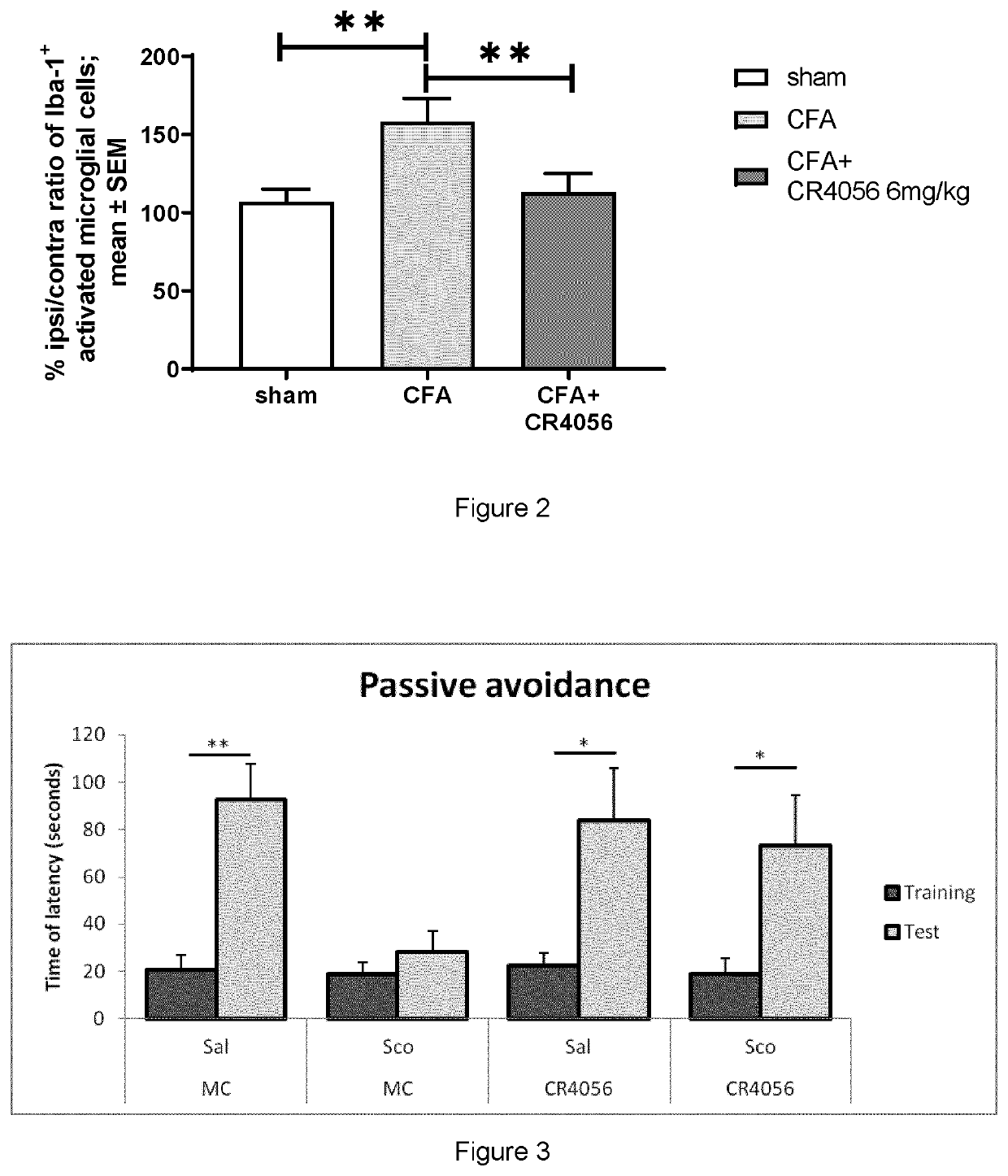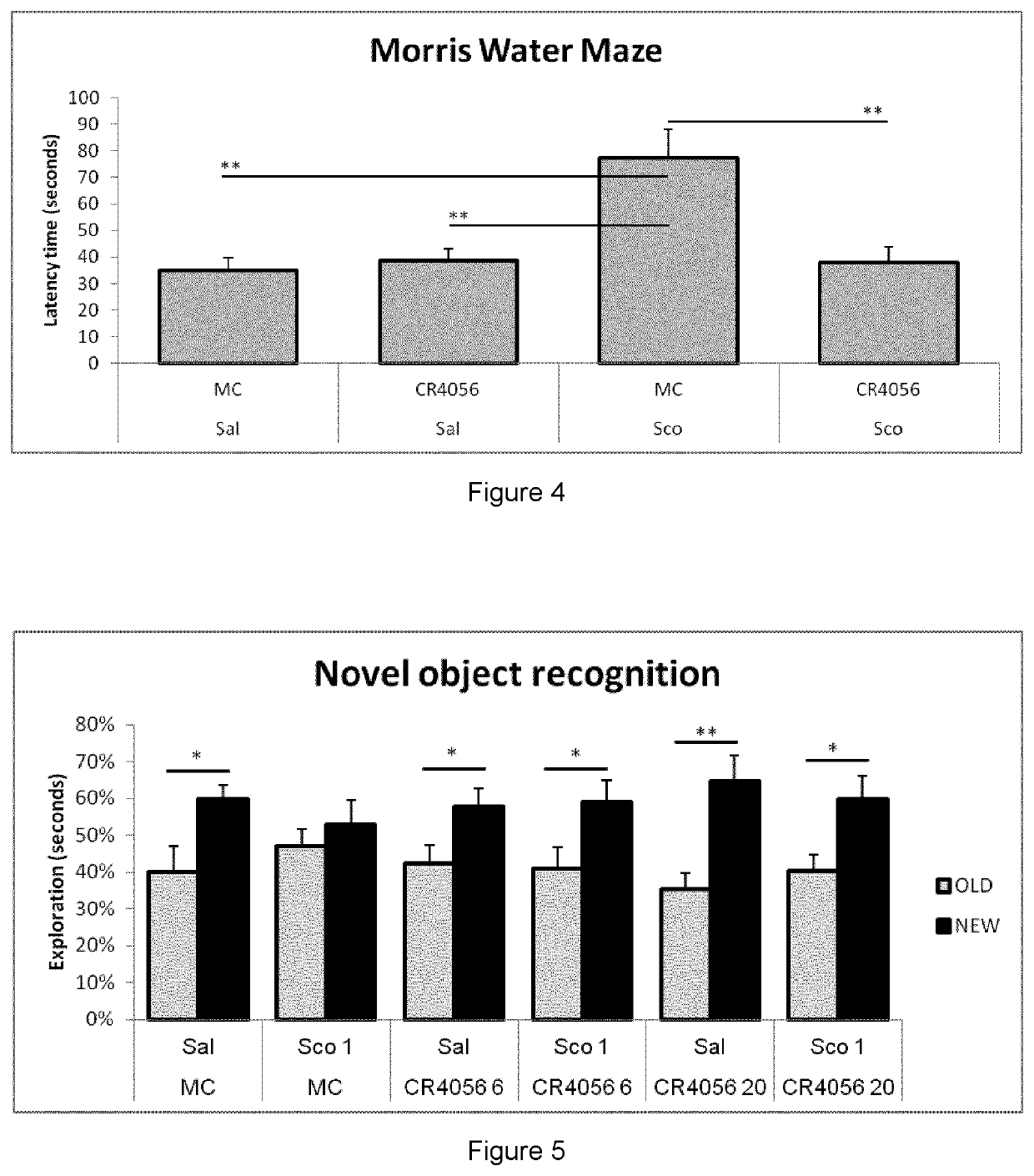Use of 2-Phenyl-6-(1H-Imidazol-1-YL) Quinazoline for Treating Neurodegenerative Diseases, Preferably Alzheimer's Disease
a technology of neurodegenerative diseases and quinazoline, which is applied in the field of 2phenyl6(1himidazol-1-yl) quinazoline to treat neurodegenerative diseases, can solve the problems of miscued signaling outputs, i2bs pharmacology remains elusive, and the growth of neurodegenerative diseases (nd) worldwide, so as to reverse memory impairment, reduce microglia activation, and improve cognitive performan
- Summary
- Abstract
- Description
- Claims
- Application Information
AI Technical Summary
Benefits of technology
Problems solved by technology
Method used
Image
Examples
example 1
Effects of 2-Phenyl-6-(1H-Imidazol-1-Yl)Quinazoline on the Expression of Inflammatory Genes
Methods
[0061]A model of astrocytes, the human glioblastoma astrocytoma cell line U373 MG (Uppsala), was used for these experiments. Adherent cells were grown in DMEM medium supplemented with 10% FBS at 37° C. with CO2. 72 hours after plating, cells were treated for 1 h with 2-phenyl-6-(1H-imidazol-1-yl)quinazoline (CR4056) (10 μm) prepared according to EP2066653 and then stimulated with the pro-inflammatory cytokine IL-1β (2 ng / mL) for further 6 and 24 h.
[0062]At the end of incubation period, total RNA was obtained and retro-transcribed using the High-Capacity cDNA Reverse Transcription Kit (Thermo Fisher Scientific). The levels of expression of COX-2, IL-2β, IL-6 and TNFα were evaluated by RT-PCR analysis, performed using the Applied Biosystems 7500 Fast Real-Time PCR System using specific TaqMan assays and, as an endogenous control, the 18S Pre-Developed TaqMan® Assay (Thermo Fisher Scientif...
example 2
Effect of 2-Phenyl-6(1H-Imidazol-1Yl) Quinazone (CR4056) on PKCε Translocation to the Plasma Membrane in Cultured Neurons
Methods
[0066]Rat dorsal root ganglia (DRGs) were obtained from freshly isolated spines after carefully removing nerve trunks and connective tissue. Larger ganglia, chopped into 2-4 smaller pieces were then incubated for 1 hour at 37° C. in 0.125% collagenase (Worthington, Freehold, N.J.) dissolved in Dulbecco's modified Eagle's medium (DMEM) containing 10% fetal bovine serum (FBS) plus 1% penicillin / streptomycin and 1% L-glutamine (Euroclone, Milan, Italy). After enzymatic digestion, ganglia were mechanically dissociated and neurons plated at a density such that neurons would cover about 30% of coverslip surface in a single layer, in petri dishes containing wells with a glass bottom coverslip (pre-coated with 10 μg / mL poly-L-lysine and 20 μg / ml laminin, Sigma-Aldrich, Milan, Italy). Cells were incubated for 2-3 days in DMEM as described above, plus 1.5 μg / ml cytos...
example 3
ffect of 2-Phenyl-6-(1H-Imidazol-1-Yl) Quinazoline (Cr4056) on Microglia Activation in Cfa Inflammatory Model
Methods
[0069]Microglial cells activation was evaluated by immunofluorescence staining, measuring the expression of ionized calcium-binding adapter molecule 1 (Iba-1) in ipsilateral L5 spinal cord in complete Freund's adjuvant (CFA) model.
[0070]Monolateral inflammation was induced by injecting 100 μL CFA (1 mg / mL diluted 1:1 with saline) into the plantar surface of the right hind paw of rats.
[0071]CR4056 (6 mg / kg, os) was administered 72 hours post-CFA and after 90 minutes animals were deeply anesthetized with an overdose of urethane (1.5 g.kg-1, i.p.) and then transcardially perfused with 250 mL 0.9% saline containing 1% heparin (5000 UI.mL-1), followed by 500 mL 10% formalin (i.e. 4% paraformaldehyde, Bio-Optica Spa, Milan, Italy). The L5 segment of the spinal cord was harvested, post-fixed overnight at 4° C. and embedded in paraffin blocks for sectioning. Transverse section...
PUM
| Property | Measurement | Unit |
|---|---|---|
| mean time | aaaaa | aaaaa |
| density | aaaaa | aaaaa |
| preincubation time | aaaaa | aaaaa |
Abstract
Description
Claims
Application Information
 Login to View More
Login to View More - R&D
- Intellectual Property
- Life Sciences
- Materials
- Tech Scout
- Unparalleled Data Quality
- Higher Quality Content
- 60% Fewer Hallucinations
Browse by: Latest US Patents, China's latest patents, Technical Efficacy Thesaurus, Application Domain, Technology Topic, Popular Technical Reports.
© 2025 PatSnap. All rights reserved.Legal|Privacy policy|Modern Slavery Act Transparency Statement|Sitemap|About US| Contact US: help@patsnap.com



